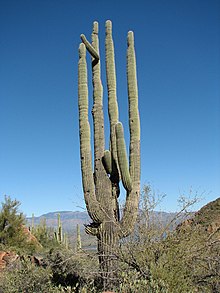User:Agbakshi/Saguaro Cactus/Bibliography
Introduction[edit]

The Saguaro Cactus, scientifically known as Carnegiea gigantea, is a large cactus that grows primarily in the Sonoran Desert of Arizona, USA, and Sonora, Mexico. This cactus is famous for its tall, tree-like form, which can reach over 40 feet in height. Saguaros are easily recognizable by their upward-reaching arms, which can number over 25 in mature plants.
Physical Characteristics[edit]
Saguaros have a long lifespan, often exceeding 150 years. They grow slowly, taking up to 75 years to develop a side arm. The cactus' skin is waxy, and its flesh contains many ribbed supports that help it expand during rainfall, storing large amounts of water. During drought, their pleats can be deeply shadowed due to contraction.
Each Saguaro's flower blooms for less than 24 hours. The flowers are white and bloom in late spring to early summer. They are self-incompatible, and thus require cross-pollination from different genetic individuals. The fruits are red, fleshy, and ripen in July; they attract various birds and wildlife.
Distribution and Habitat[edit]
The Saguaro Cactus is endemic to the Sonoran Desert. It thrives in hot climates without much frost. The Saguaro does not handle cold weather well and can die if temperatures fall below freezing for an extended period.
Ecological Role[edit]
The Saguaro Cactus provides essential support for desert ecosystems. It offers food and shelter to a variety of desert dwellers, including birds like the Gila Woodpecker, which creates nesting holes in older saguaros. These cavities are later used by other species as well.
Cultural Significance[edit]
The Saguaro has been an important plant to Indigenous peoples of the Sonoran Desert area, such as the Tohono O'odham, who use the fruit for food and traditional ceremonies. The iconic silhouette of the Saguaro is also a common symbol of the American Southwest, appearing in many forms of media and art.
Conservation Status[edit]
While not currently listed as endangered, the Saguaro Cactus faces threats from climate change and urban expansion. Conservation efforts are focused on protecting its natural habitat and preventing over-collection.
Bibliography[edit]
Drezner, Taly. Saguaro (Carnegiea gigantea) Demography and Reproduction. Forest Ecology and Management, 2003. This peer-reviewed article explores the demographic patterns and reproductive strategies of the Saguaro Cactus.
Plagens, Michael J. Sonoran Desert Naturalist Field Guide. Sonoran Desert Naturalist, 2019. A practical guide to the flora and fauna of the Sonoran Desert, with specific information on the Saguaro Cactus.
Alcorn, Stanley M. "The Saguaro Cactus and Its Community." College of Agriculture, University of Arizona, 1981. This older but still relevant publication discusses the biological community surrounding the Saguaro Cactus.
Steenbergh, Warren F., and Lowe, Charles H. Ecology of the Saguaro: I. The Role of Freezing Weather in a Warm-Desert Plant Population. Scientific Monograph Series No. 7, National Park Service, 1969. This foundational study discusses the impact of freezing temperatures on Saguaro populations.
National Geographic. "Saguaro Cactus: Icon of the Desert." 2020. An article providing an overview of the Saguaro Cactus, emphasizing its ecological and cultural importance. Available online: https://www.nationalgeographic.com.
References[edit]
Arizona-Sonora Desert Museum. "Saguaro Cactus - Carnegiea gigantea." https://www.desertmuseum.org/books/nhsd_saguaro.php.
National Park Service. "Saguaro Cactus." Saguaro National Park, 2021. https://www.nps.gov/sagu/learn/nature/saguaro-cactus.htm.
Hodgson, Wendy C. Food Plants of the Sonoran Desert. University of Arizona Press, 2001. ISBN: 978-0816522590.
Yetman, David. The Great Cacti: Ethnobotany & Biogeography. University of Arizona Press, 2007. ISBN: 978-0816524310.
Turner, Raymond M., Bowers, Janice E., and Burgess, Tony L. Sonoran Desert Plants: An Ecological Atlas. University of Arizona Press, 2005. ISBN: 978-0816524235.
